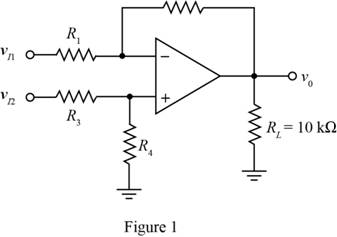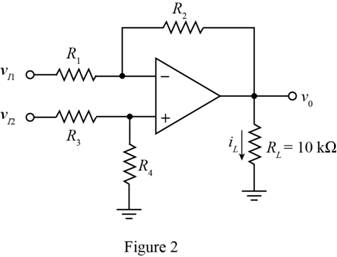
Consider the differential amplifier shown in Figure 9.24(a). Assume thateach resistor is
(a)
The value of the worst case common mode gain.
Answer to Problem 9.62P
The value of the worst case common mode gain is
Explanation of Solution
Calculation:
The given diagram is shown in Figure 1

Mark the voltages and redraw the circuit.
The required diagram is shown in Figure 2

The expression for the common mode voltage gain is given by,
The expression for the value of the voltage
The expression for the voltage
Apply KCL at the inverting terminal.
Substitute
Substitute
The expression for the common node input voltage is given by,
The expression for the common node input voltage is given by,
Substitute
Substitute
In the above equation the worst case
For worst condition the value of the resistance
For worst condition the value of the resistance
For worst condition the value of the resistance
For worst condition the value of the resistance
Substitute
Conclusion:
Therefore, the value of the worst case common mode gain is
(b)
The value of the CMRR and the common mode gain.
Answer to Problem 9.62P
The value of
Explanation of Solution
Calculation:
The expression for the common mode gain is given by,
The expression for the differential voltage is given by,
Substitute
The expression for the voltage
The expression for the common mode voltage is given by,
Substitute
Substitute
Substitute
Substitute
Substitute
The expression for the
Substitute for
Substitute
Substitute
Substitute
Substitute
Substitute
Substitute
Conclusion:
Therefore, the value of
Want to see more full solutions like this?
Chapter 9 Solutions
Microelectronics: Circuit Analysis and Design
- Q3: Material A and Material B are collected in a tank as shown where the system consists of three Push-Button, three Level Sensors, two Inlet valve, one Outlet valve, Heater, Temperature Sensor, Agitator Motor, and Alarm Light. Material A and Material B are to be mixed and heated until it reaches 90°C temperature, and it will be drain using outlet valve also high-level Alarm Light will come ON when the tank is full and stay on even if the tank level drops until the operator press Reset Push-Button. Implement automation of this system in PLC using Ladder Diagram programming language (Note: The tank is fed with Material A before B and the temperature sensor can withstand 200°C and it gives voltage from 0 to 10 volts) (25 Marks) Valve A Agitator Motor Valve B Level B Heater E Level A Low Level Sta Start Push-Button Stop Push-Button 36. ویر نکند Temperature sensor Outlet Valve Reset Push-Button Alarm Lightarrow_forward.Explain how a gated J-K latch operates differently from an edge-triggered J-K flip-flop. . For the gated T Latch circuit, answer the following: a) Draw the gate-level diagram of a gated T latch using basic logic gates and SR latch b) Write the characteristic equation. c) Draw the state diagram.arrow_forwardA Digital Filter is described by the following. difference equation: Y(n)=0.5x(n) 0.5(n-2) - Find the transfer function ..arrow_forward
- Q4) answer just two from three the following terms: A) Design ADC using the successive method if the Vmax=(3) volt, Vmin=(-2) volt, demonstrate the designing system for vin-1.2 volt.arrow_forward(a) For a voltage phasor V(jω) and a current phasor I(jω), give an expression for the complex power.(b)Give three examples of how real (average) power might be dissipated.(c)A time-domain voltage is defined by the expression v(t)= 5 cos(πt/3) V. When this is applied across an impedance Z = 4∠60° Ω, determine:(i)The instantaneous power.(ii)The average power.arrow_forwardConsider the LTI system with the input x(t) = e^28(t) and the impulse response h(t) = e−²tu(t). a) Determine the Laplace transform of x(t) and h(t). (10 marks) b) Using convolutional property, determine the Laplace transform and the ROC for the output response y(t).arrow_forward
- (A) Consider a communication system where the number of successful transsions out of 10 trials follows a binomial distribution. The success probability for each triat is 0,95, Let X be the random variable representing the number of successful transmissions. -Sketch the cumulative distribution function (CDF) of the distribution. 2- Find Skewness coefficients and check if the distribution is symmetrical or skewed to the right or left. 3- Find kurtosis coefficients, Check if the distribution is mesokurtic, leptokurtic or platykurtic. 4- Find the probability of getting at most eigh. successful transmissions. 5- Find the probability P(20 with a mean 2-1 calculate the probability that the noise is greater than 3 units.arrow_forwardQ4: (A) Find the mean of a random variable X if S f(x)= 2x 0 2 for 0arrow_forward(A) Suopces the current measurements in a strip of wire are normally distributed with ca-10(mA) and a varieocom (mA)² 1- What is the probability that a current measurement lies between 7.4 and 11.6 mA? 2-Drew the probability density function of the current distribution. (8) A factory produces light bulbs with a koown probability of P(D)-0.08 that & bulo is dalective. If a bulb is defective, the probability that the quality control test detects it is defective is P(TID)-0.90. Conversely, if a bulb is not defective, the probability that the test Telesly indicaton k as defective is P(TID)-0.05. calculate the probability that a light b is notually defective given that the test result is positive, F(DIT).arrow_forwardarrow_back_iosSEE MORE QUESTIONSarrow_forward_ios
 Introductory Circuit Analysis (13th Edition)Electrical EngineeringISBN:9780133923605Author:Robert L. BoylestadPublisher:PEARSON
Introductory Circuit Analysis (13th Edition)Electrical EngineeringISBN:9780133923605Author:Robert L. BoylestadPublisher:PEARSON Delmar's Standard Textbook Of ElectricityElectrical EngineeringISBN:9781337900348Author:Stephen L. HermanPublisher:Cengage Learning
Delmar's Standard Textbook Of ElectricityElectrical EngineeringISBN:9781337900348Author:Stephen L. HermanPublisher:Cengage Learning Programmable Logic ControllersElectrical EngineeringISBN:9780073373843Author:Frank D. PetruzellaPublisher:McGraw-Hill Education
Programmable Logic ControllersElectrical EngineeringISBN:9780073373843Author:Frank D. PetruzellaPublisher:McGraw-Hill Education Fundamentals of Electric CircuitsElectrical EngineeringISBN:9780078028229Author:Charles K Alexander, Matthew SadikuPublisher:McGraw-Hill Education
Fundamentals of Electric CircuitsElectrical EngineeringISBN:9780078028229Author:Charles K Alexander, Matthew SadikuPublisher:McGraw-Hill Education Electric Circuits. (11th Edition)Electrical EngineeringISBN:9780134746968Author:James W. Nilsson, Susan RiedelPublisher:PEARSON
Electric Circuits. (11th Edition)Electrical EngineeringISBN:9780134746968Author:James W. Nilsson, Susan RiedelPublisher:PEARSON Engineering ElectromagneticsElectrical EngineeringISBN:9780078028151Author:Hayt, William H. (william Hart), Jr, BUCK, John A.Publisher:Mcgraw-hill Education,
Engineering ElectromagneticsElectrical EngineeringISBN:9780078028151Author:Hayt, William H. (william Hart), Jr, BUCK, John A.Publisher:Mcgraw-hill Education,





